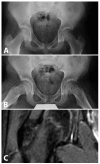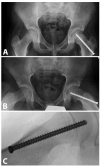MRI in idiopathic, stable, slipped capital femoral epiphysis: evaluation of contralateral pre-slip
- PMID: 30294369
- PMCID: PMC6169561
- DOI: 10.1302/1863-2548.12.170204
MRI in idiopathic, stable, slipped capital femoral epiphysis: evaluation of contralateral pre-slip
Abstract
Purpose: Early diagnosis and treatment of slipped capital femoral epiphysis (SCFE) is important to prevent slip progression and avoid complications. We sought to determine if MRI findings in patients with unilateral SCFE could indicate 'pre-slip' or predict future SCFE in the contralateral hip.
Methods: A prospective study evaluated patients with unilateral SCFE over a two-year period. MRI of the asymptomatic hip was performed within the perioperative period. Patients were followed with radiographs until a contralateral slip occurred or until physeal closure. Demographics, clinical stability, severity, posterior slope angle (PSA), modified Oxford Bone Score (mOBS) and patency of the triradiate cartilage were recorded and statistical analysis performed.
Results: In all, 33 of 54 patients with unilateral SCFE were enrolled into the study. In all, 29 (87.8%) had complete follow-up. Five of the enrolled patients (15.2%) developed a sequential slip requiring in situ pinning. Six of 33 (18.2%) patients had positive MRI findings: four of which proceeded to sequential SCFE and two which did not. One sequential slip had a negative MRI. PSA predicted 1/11 sequential slips (sensitivity 9.09%, specificity 81.4%, positive predictive value (PPV) 11.1%, negative predictive value (NPV) 77.8%) and mOBS predicted 5/11 sequential slips (sensitivity 45.5%, specificity 93%, PPV 62.5%, NPV 87%). An open triradiate cartilage was present in 8/11 patients with sequential slips (sensitivity 72.7%, specificity 81.4%, PPV 50%, NPV 92.1%).
Conclusion: MRI findings consistent with 'pre-slip' were present in 66.7% of patients who developed a sequential SCFE. Further study on the utility/sensitivity of MRI in predicting sequential SCFE is warranted.
Level of evidence: II, diagnostic.
Keywords: MRI; asymptomatic hip; modified Oxford Bone Score; posterior slope angle; slipped capital femoral epiphysis.
Figures



Similar articles
-
Morphologic Features of the Contralateral Femur in Patients With Unilateral Slipped Capital Femoral Epiphysis Resembles Mild Slip Deformity: A Matched Cohort Study.Clin Orthop Relat Res. 2018 Apr;476(4):890-899. doi: 10.1007/s11999.0000000000000127. Clin Orthop Relat Res. 2018. PMID: 29481345 Free PMC article.
-
Does skeletal maturity predict sequential contralateral involvement after fixation of slipped capital femoral epiphysis?J Pediatr Orthop. 2007 Oct-Nov;27(7):796-800. doi: 10.1097/BPO.0b013e3181558bd9. J Pediatr Orthop. 2007. PMID: 17878787
-
Prediction of contralateral slipped capital femoral epiphysis using the modified Oxford bone age score.J Pediatr Orthop. 2012 Apr-May;32(3):290-4. doi: 10.1097/BPO.0b013e3182471eb4. J Pediatr Orthop. 2012. PMID: 22411336
-
Predicting subsequent contralateral slipped capital femoral epiphysis: an evidence-based approach.J Child Orthop. 2020 Apr 1;14(2):91-97. doi: 10.1302/1863-2548.14.200012. J Child Orthop. 2020. PMID: 32351620 Free PMC article. Review.
-
Factors Affecting Outcomes of Slipped Capital Femoral Epiphysis.Cureus. 2020 Feb 5;12(2):e6883. doi: 10.7759/cureus.6883. Cureus. 2020. PMID: 32190446 Free PMC article. Review.
Cited by
-
The contralateral hip in slipped capital femoral epiphysis: Is there an easy-to-use algorithm to support a decision for prophylactic fixation?J Child Orthop. 2022 Aug;16(4):297-305. doi: 10.1177/18632521221107748. Epub 2022 Aug 2. J Child Orthop. 2022. PMID: 35992523 Free PMC article.
-
Novelties in slipped capital femoral epiphysis imaging: A narrative review.Heliyon. 2024 Apr 5;10(7):e28734. doi: 10.1016/j.heliyon.2024.e28734. eCollection 2024 Apr 15. Heliyon. 2024. PMID: 38617959 Free PMC article. Review.
-
Prophylactic fixation of the unaffected contralateral side in children with slipped capital femoral epiphysis seems favorable: A systematic review.World J Orthop. 2022 May 18;13(5):515-527. doi: 10.5312/wjo.v13.i5.515. eCollection 2022 May 18. World J Orthop. 2022. PMID: 35633749 Free PMC article.
-
Slipped capital femoral epiphysis (SCFE) a structured approach for the FRCS examination.Eur J Orthop Surg Traumatol. 2025 Jun 24;35(1):275. doi: 10.1007/s00590-025-04391-5. Eur J Orthop Surg Traumatol. 2025. PMID: 40553203 Review.
-
Clinical Diagnosis of Slipped Capital Femoral Epiphysis in a Child With Negative Radiological Findings: A Case Report.Cureus. 2023 Jan 5;15(1):e33396. doi: 10.7759/cureus.33396. eCollection 2023 Jan. Cureus. 2023. PMID: 36618493 Free PMC article.
References
-
- Cowell HR. The significance of early diagnosis and treatment of slipping of the capital femoral epiphysis. Clin Orthop Relat Res 1966;48:89–94. - PubMed
-
- Leunig M, Casillas MM, Hamlet M, et al. . Slipped capital femoral epiphysis: early mechanical damage to the acetabular cartilage by a prominent femoral metaphysis. Acta Orthop Scand 2000;71:370–375. - PubMed
-
- Loder RT. The demographics of slipped capital femoral epiphysis. An international multicenter study. Clin Orthop Relat Res 1996;322:8–27. - PubMed
-
- Gelberman RH, Cohen MS, Shaw BA, et al. . The association of femoral retroversion with slipped capital femoral epiphysis. J Bone Joint Surg [Am] 1986;68-A:1000–1007. - PubMed
-
- Gholve PA, Cameron DB, Millis MB. Slipped capital femoral epiphysis update. Curr Opin Pediatr 2009;21:39–45. - PubMed
LinkOut - more resources
Full Text Sources
Research Materials
Miscellaneous

